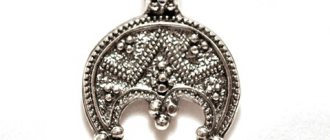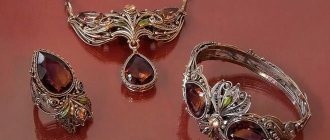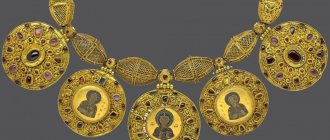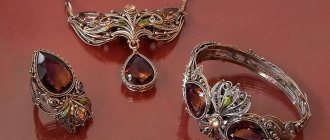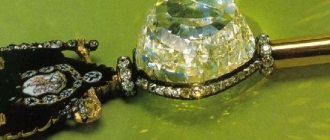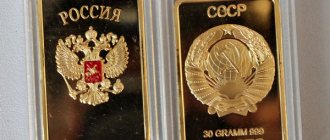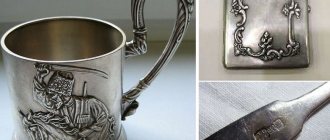became widespread in Russia Objects for worship were made from it - chalices, candelabra, frames for images. Soft and malleable silver alloys were suitable for creating the most intricate shapes and finishing motifs. Due to its bactericidal properties, the material has found wide use in the manufacture of vessels for holy water. Silver jewelry in Russia, until the discovery of deposits, was available only to the nobility.
Russia's silver in the pre-Petrine era was mostly imported. It was delivered from the countries of the East and Europe in crushed form, ready for melting. Master jewelers used coins and bars that merchants used to pay. Very few large items from the early Middle Ages have survived, since items that went out of use were immediately melted down.
Silver in Russia began to be scarce in the 14th century - deposits in the Eastern countries were gradually depleted, and Western Europe reduced the export of coins due to huge expenses on the Crusades. The development of jewelry was also delayed by the Mongol-Tatar invasion - the death of cities and the destruction of trade relations led to the fact that complex techniques for processing and decorating products were forgotten for a long time.
Jewelry craft developed in those regions that were not occupied by the Mongol-Tatars. Archaeological excavations at the site of ancient Novgorod indicate that several dozen workshops operated in the city, producing jewelry and church utensils. The techniques used were wax casting, free forging, embossing, engraving, embossing and soldering. The main supplier of silver for the Novgorodians was the Hanseatic League. One ship brought up to 80 thousand coins.
Russian art was closely connected with Byzantine artistic traditions. Greek jewelers worked in Kyiv, and students from the local population learned the secrets of their craft from them. Products brought from Constantinople served as a standard - copies were made from them, sometimes modified and national flavor was added. Silver frames from this period have survived to this day.
The history of silver hallmarking in Rus' before the reign of Peter I has been little studied. Until the end of the 17th century, the sample was “unestablished” (unidentified), since they simply did not know how to determine the purity of the alloy. The samples used were efimkas and levkas - coins that were given by elders to jewelers and merchants to determine the quality of silver.
In October 1700, the royal order was issued to make four silver samples in the Armory Chamber. The production was carried out by the Russian master Panteleimon Afanasyev. Three samples exactly matched the 96, 90 and 84 spool samples. The fourth alloy had a high admixture of copper, its purity was still determined “against the gesso” (since 1711 - 62 samples). From that moment on, even provincial workshops, which were previously allowed not to do so, were obliged to brand products.
Hieronymus Pozier
Bouquet of flowers. Gold, silver, precious and semi-precious stones, crystal. Cutting, polishing. 1740s. Photo: foto-basa.com
Large imperial crown. 1762. Photo: gold.ru
Bouquet of flowers. Gold, silver, precious and semi-precious stones, glass, fabric. Cutting, polishing. 1740s. Photo: foto-basa.com
Hieronymus Pozier was the jeweler of three empresses - Anna Ioannovna, Elizaveta Petrovna and Catherine the Great. He and his father came to Russia on foot from Switzerland in 1729. Here Pozier studied in the workshop of the French engraver Benoit Gravero and in 1740 opened a workshop. Anna Ioannovna patronized him.
In his works, the court jeweler assigned a special role to stones. His main creation was the Great Imperial Crown for the coronation of Catherine the Great. The master set pearls, Indian diamonds, and rubies in gold and silver. He worked on the crown weighing 2.34 kilograms for only two months. A year after the coronation of Catherine the Great, the famous jeweler left Russia. And for several centuries all the emperors of Russia were crowned with the Pozier crown.
Viren Bhagat - a synthesis of innovation and tradition
This Indian artisan comes from a family that has been making accessories for over 100 years. The man began drawing sketches of works in early childhood, but at the same time he treats each product as a unique masterpiece. In a year, Viren Bhagat creates no more than 60 items, combining the refined lines of Art Deco with the luxury inherent in the Mughal Empire. Therefore, you can only buy jewelry made according to a designer’s design on an individual order.
The master’s favorite materials are pearls, sapphires, emeralds and diamonds, as well as platinum. In addition, he patented a new type of diamond processing, when the stones resemble the thinnest petals - in combination with an almost invisible frame, they look incomparable!
Olovyanishnikov Dynasty
Bells for Bulgaria. 1877. Photo: wikimedia.org
Bowl for storing prosphora. XIX century Photo: modusvivendi.ru
Church utensils. XIX century Photo: wikimedia.org
For two centuries, the Olovyanishnikov jewelry dynasty cast entire “bell families” and valuable church utensils. Representatives of the creative dynasty cast the first bells in the first half of the 18th century. Three brothers - Fyodor, Porfiry and Kliment Olovyanishnikov - became merchants of the third guild and ran a common business. To cast the bells, they invited the best acoustician of their time, the inventor of the bell tuning fork, Aristarchus of Israel. The “Russian style” of the Olovyanishnikovs’ church utensils is the merit of the artist Sergei Vashnikov, Viktor Vasnetsov’s favorite student. The bells, caskets, and miters of the Olovyanishnikovs “toured” all over the world. They exhibited in Paris, New Orleans, and Chicago. The craftsmen were also valued in their homeland: “In recognition of exceptional services to Russia,” the plant received the right to depict the imperial coat of arms on its products.
Silversmithing in the 18th century
Immediately after the founding of St. Petersburg, Peter I invited artisans from Europe to the new Russian capital, among whom were many gold and silversmiths. In 1714, the emperor allowed jewelers to create workshops, which were headed by a headman endowed with special powers.
In the first half of the 18th century, they first began to differentiate jewelers by profile and workshops appeared that specialized only in silver, although many also worked with gold. Russian craftsmen soon united into one workshop, which included:
- court jeweler Pazunov (Pazulov);
- Samson Larionov;
- Fedor Razumov;
- Mikhail Belsky;
- Ivan Libman.
In 1793, the Russian workshop consisted of 44 jewelers, each master was required to mark his product. Information about stamps from that period is very scarce. It is known that so-called “name tags” were applied to the products, which consisted of the manufacturer’s initials. Towards the end of the 18th century, in order to avoid confusion, masters began to indicate their full first and last names on their creations. It was not necessary to register such marks, so the markings of that time are diverse.
During this period, silver mining in Russia was already in full swing. In 1704, the Nerchinsk silver smelting plant began operating, and coins were minted in the capital. With the discovery of the Altai and then Pechora deposits, the issue of silver ore production was finally resolved. The development of the mining industry was also facilitated by the fact that until 1782, anyone was allowed to search for and smelt precious metals.
The transformations of the first Russian emperor led to changes in the lifestyle of the nobility. Following European customs, new household items appeared in everyday life: silver accessories, tableware, toiletries. Throughout the 18th century, styles changed - under Peter and Elizabeth, baroque came into fashion, during the “golden age” of Catherine II, rococo and classicism gained popularity. Products of this era are characterized by a mixture of trends - elements of different styles could be combined in the decoration of one item.
Pavel Sazikov
Samovar in neo-Rococo style. Russian Empire, Moscow. 1839. Photo: lermontovgallery.ru
Vase for wine. Russian Empire, St. Petersburg. 1880. Photo: lermontovgallery.ru
Mug in historicism style. Russian Empire, Moscow. 1873. Photo: lermontovgallery.ru
One of the oldest jewelry firms in Russia was founded in Moscow in 1793 by the third guild merchant Pavel Sazikov. Over two decades, the small workshop grew into a silverware factory. In the mid-19th century, her products created a real sensation at the World Exhibition in London. Moscow jewelers presented silver objects there - a collection based on peasant life. For the first time, elite jewelry art “came closer to the earth”: a dancing bear, a Cossack woman with a bandura, a hunter with a hare surprised the guests of the exhibition with both unusual subjects and skillful work.
For the high quality of his embossed products, Ignatius Sazikov was called the Russian Benvenuto Cellini - in honor of the famous Italian jeweler. The master gave even ordinary ink utensils a national flavor: for example, he created a village hut surrounded by objects of peasant life - from a well to poultry. Sazikov brought from France to Russia one of the first guilloche machines - a device for applying patterns. For the first time, a department for training silver and goldsmiths was opened at his factory.
Diamonds go beyond the edge
The publication is unique, Gokhran notes. Firstly, it united masters of various schools and directions. Specialists in ceramics and porcelain, Orthodox enamel, jewelry, arts and crafts, and weapons. Masters of bone carving and stone cutting art. And this is not the whole list.
“In modern Russia there has never been such a large-scale catalogue. Those that were published earlier united a smaller number of masters and a certain profile,” says the author of the book, director of the Creative Union of Artists of Decorative and Applied Arts Sergei Kolomiytsev. And this greatly hampered the progress of our specialists.
Even in Russia they are almost unknown. Students and graduates of art educational institutions admit that they have no one to study with, no one to look up to, and they know little about contemporary Russian art.
“We are accustomed to the stars of jewelry art being Faberge, Sazikov, Ovchinnikov. And few people know modern ones. The idea arose to show the Russian style, the national style,” explained Sergei Kolomiytsev.
According to Svetlana Gnutova, head of the arts and crafts sector of the Andrei Rublev Central Museum of Ancient Russian Culture, modern arts and crafts are characterized by a new interpretation of the Old Russian and Byzantine heritage.
Little is known about Russian masters abroad. Not everyone has the financial opportunity to participate in international exhibitions and express themselves. And even those whom they know and respect do not often have the opportunity to remind themselves. And there is something to show. For example, Dmitry Samorukov, a master of the Russian Guild of Cutters, works according to a unique method he developed, which is not yet used anywhere else in the world. And his products are extraordinary. Imagine cubic zirconias, pearls, and other stones that have 200 - 300 facets. They don't just shimmer with all the colors of the rainbow. They seem to live, breathe, create a new world. “The cut doesn’t just highlight the beauty of the stone. These are pictures written with symbols. They make the world cleaner and people kinder,” admits the master. His works have been exhibited at Russian and international exhibitions more than once. But getting into the book opens up new possibilities. The catalog is of interest both in the Russian Federation and in the West. The publication was published in a circulation of one thousand copies and has already sold out. Therefore, its re-release is planned in the near future. There is also a release in English.
We are accustomed to the fact that the stars of jewelry are Faberge and Sazikov. But modern masters are no worse
According to the head of the Gokhran of Russia Andrei Yurin, this book is of great importance. Firstly, it is needed by consumers of decorative and applied arts, from museums to “private owners” who collect unique items, including jewelry. And the catalog gives them an idea of the artists, their work and capabilities. Secondly, it is important for researchers studying art, new ideas, forms, technologies that appear in it. Our organization is also doing this, he clarifies.
Thirdly, it gives an idea of our art to foreign partners. Both in Eastern Europe and Asia there are people and organizations who are interested in Russian arts and crafts, schools that study it. And there are those who would like to purchase the products of our masters.
On the day of the presentation, a one-day exhibition was opened at Gokhran, which presented the works included in the book, essentially its living illustrations. “Truly unique works, created in a single copy,” says Andrey Yurin.
“In our economically difficult times, we see the revival of the Russian jewelry school, the emergence of new names and creative workshops. Modern jewelry and art products are not inferior to the products of the most famous foreign jewelry companies,” says Alexander Stolyarevich, chief expert of the Gemological Center of Moscow State University.
Sergei Kolomiytsev admitted to RG: many of the names presented in the catalog book are not known to the general public. But they know abroad that there are such masters with a capital “M” in Russia, there are schools, there are unique techniques. “Currently, there are few specialists left in the West who are capable of creating such fine, unique pieces of jewelry. The school is almost lost in England. There is a shortage of craftsmen in Germany. Our creative union often receives proposals for the exchange of experience, requests to accept their specialists for training,” he says. But he adds that cooperation does not always work out.
“If our delegation travels to Europe, the receiving party provides accommodation in a municipal hotel, organizes exhibitions of the works of our masters, and provides advertising,” continues Kolomiytsev. “We don’t yet have such organizational capabilities.” And he adds that when a famous foreign jeweler comes to Russia with a personal exhibition, he shows great interest in communicating with our craftsmen and their work.
Karl Bohlin and Gottlieb Jan
Ladle. Silver, enamel. 1908–1917. Photo: qna.center
Caviar. Silver, crystal. Casting, chasing, engraving, gilding, diamond cutting. 1908–1917. Photo: qna.center
Box in the shape of a butterfly. Silver, diamonds, pearl, enamel. 1898–1908. Photo: qna.center
Petersburgskaya made precious jewelry and gifts for the royal family and courtiers. The company was founded by Karl Bohlin and Gottlieb Jan, two sons-in-law of the famous Saxon master Andreas Rempler, who served at the court of Paul I.
worked under six Russian monarchs and carried out orders from the imperial palace for more than a century. The Review of the London World's Exhibition of 1851 said that Bohlin's work "decidedly surpassed in perfection of setting everything that was in the exhibition, not even excluding the diadem of the Spanish Queen by the famous Parisian jeweler Lemonnier." In 1912, Nicholas II granted the family hereditary nobility. Today, the jewelers’ works are stored in the Diamond Fund and have the status of crown treasures.
A little history of Russian enamel
Artistic painting on metal - enamel, or, as it was called until the 19th century - enamel, was known in Ancient Rus'. Jewelers of all subsequent centuries turned to it. This technique was used to decorate a wide variety of expensive items for household and religious purposes - chalices, bowls, panagias, frames for icons and books. Enamel was also widely used to decorate palace and ceremonial items - state regalia, hats, weapons, costumes, and precious items. It was also found on cheaper household items - earrings, rings, crosses, boxes, which were used mainly among peasants.
But enamel was most widely used to decorate items for decorative and gift purposes - dishes and cutlery, brooches and hairpins, handles for canes and cigarette cases. And, as a rule, such jewelry items were often made according to special orders and presented by wealthy citizens to each other as exclusive gifts for holidays and other significant dates.
Artistic Russian enamels of the “Golden Age”.
And at the turn of the 19th - 20th centuries, having experienced its revival, enamel art reached its peak of popularity. It was at that time that the “Russian style” became incredibly fashionable among members of the royal family and the Russian nobility. Turning to their roots, many began to build houses in the style of medieval boyars' mansions, and also order jewelry with openwork colored elements and picturesque fairy-tale scenes. At the end of the 19th century, many such works were carried out by suppliers of the imperial court - the famous jewelry firms of Carl Faberge, Pavel Ovchinnikov, Ivan Khlebnikov, Fyodor Rückert, and the Grachev Brothers. It was decorative enamels that brought fame throughout the centuries to these masters of jewelry art, who brought their artistic craft to perfection.
Artistic Russian enamels of the “Golden Age”.
It was during this period that St. Petersburg and Moscow became trendsetters for products made from enamels: large jewelry companies opened their own enamel schools and produced products in a wide variety of styles - from ancient Russian designs in folk style to baroque and art nouveau, striking with the richness of colors and sophistication of patterns.
Emperor Nicholas II was a big fan of silver items with enamels. His collection included many items made using this jewelry technique. By the way, in our time this collection is sometimes exhibited in the exhibition halls of the Hermitage.
Pavel Ovchinnikov
Salt shaker with enamel. Russian Empire, Moscow. 1899–1908. Photo: lermontovgallery.ru
Beer mug "Peasants returning from haymaking." Russian Empire, Moscow. 1873. Photo: lermontovgallery.ru
Ladle. Russian Empire, Moscow. 1899–1908. Photo: lermontovgallery.ru
The famous manufacturer and goldsmith was a serf of Prince Dmitry Volkonsky. He was fond of drawing, and the talented boy was sent to Moscow to develop his abilities. In 1850, Pavel Ovchinnikov received his freedom, got married, and started his own business with his wife’s dowry.
Ivan Khlebnikov
Golden teapot. Gilding, enamel. Russian style. Photo: lermontovgallery.ru
Cup holder. Silver. Russian Empire, Moscow. 1893. Photo: lermontovgallery.ru
Bowl. Gilding, cloisonné enamel. Russian style. Photo: lermontovgallery.ru
The products of Ivan Khlebnikov were known for a variety of styles in Tsarist Russia: new Russian, neo-baroque, neo-rococo, neoclassicism, modern. The jeweler founded the factory in Moscow in 1871. Just two years later, Khlebnikov took to the World Exhibition in Vienna a massive bowl in the spirit of the times of Tsar Alexei Mikhailovich and a mug with a relief image of Dmitry Donskoy. “Items that smelled like antiquity” - this is how famous jewelers described them. Historical and literary characters became Ivan Khlebnikov’s favorite subjects. He produced precious plates depicting scenes from the life of Ivan the Terrible and a feast from Mikhail Lermontov’s poem “The Song of the Merchant Kalashnikov.”
Khlebnikov, together with leading Russian jewelers, participated in the decoration of the Cathedral of Christ the Savior. He created more than fifty lamps, tabernacles, and jugs for holy water. For the Annunciation Cathedral of the Kremlin, a gilded and enamel iconostasis was made at his factory.
Carl Faberge
Faberge Egg “Basket of Flowers”. 1901. Photo: happymodern.ru
Golden basket with lilies of the valley. 1901. Photo: lermontovgallery.ru
Faberge Egg "Bay Tree". 1911. Photo: happymodern.ru
Hereditary jeweler Carl Faberge was raised in classical traditions. He combined elements of sculpture, painting and graphics in his precious products, and also tried to revive in them the emotions and memories of his crowned customers. An example of such synthesis is Easter eggs. They were created by a huge creative team of 600 craftsmen from all over the world. The tradition of giving each other precious gifts for Easter appeared in the imperial family in the second half of the 19th century. Alexander III ordered the first egg for Empress Maria Feodorovna, Nicholas II gave precious gifts to both his mother and his wife Alexandra Feodorovna every spring. After one of the exhibitions of Carl Faberge, Alexander III noted that his works should be kept in the Hermitage as an example of the skill of Russian jewelers.
Michelle Ong – harmony of form and style
This fragile Asian woman refuses to present her creations to the public until they seem perfect to her. And such exactingness justifies itself - the name of the craftswoman has long become synonymous with filigree elaboration of every detail. It's no wonder that her accessories made of diamonds, pink sapphires, emeralds, jadeite and titanium are happily worn by Kate Winslet, Glenn Close and Reese Witherspoon.
Michelle was born into a family of doctors in Hong Kong and, at the insistence of her parents, had to receive a sociological education. But one day she decided to realize her dream - to become a designer. To do this, the girl became an apprentice to a diamond importer. And already in 1985 she founded, which in 2003 turned into the jewelry house “Carnet by Michelle Ong”.
Grachev brothers
Tea-set. Russian Empire, St. Petersburg. 1886. Photo: lermontovgallery.ru
Decanter. Russian Empire, St. Petersburg. 1888–1890s. Photo: lermontovgallery.ru
Salt shaker with enamel. Russian Empire, St. Petersburg. 1899–1908. Photo: lermontovgallery.ru
The jewelry house of the Grachev brothers was famous throughout St. Petersburg for its products in the Art Nouveau and Russian styles. Masters often made replicas of ancient masterpieces. They used both the traditional technique of enamel on filigree and carving, and stained glass enamel, which was innovative in those years. Ornate ornaments, portraits and landscapes on gold and silver were covered with a thin translucent enamel layer.
The head of the jewelry house was Gabriel Grachev, his business was inherited by eight sons. By 1895, the small workshop became a factory; one of the brothers, Mikhail Grachev, was appointed a full-time appraiser for the Imperial Cabinet. The Grachev Jewelry House was a supplier to the Imperial Court until 1917. After the revolution, the factory stopped producing precious icon frames and exquisite interior items; the range was narrowed to simple silverware. In 1918, the jewelry house closed.
The decline of pre-revolutionary jewelry art
The February events of 1917 forced many aristocrats to emigrate, which led to the closure of some workshops. The October Revolution finally destroyed wealthy customers, and robberies forced the vast majority of jewelers to flee to Europe. In 1918, searches began in large and small workshops; revolutionary sailors took away everything that looked like gold, silver and precious stones.
A huge amount of jewelry was sold abroad, and the proceeds went to fuel the world revolution. The commission created by the Bolshevik government did not understand the artistic value of silver items from the 19th century. The masterpieces of Sazikov, Faberge, Ovchinnikov and Khlebnikov were not melted down only for the reason that it was unprofitable.
Many items with museum value from private collections were presented to the Red Guards as rewards for military services. In the 1920s, a store opened in Leningrad where they sold palace property as old trash in an attempt to get at least some money for it. As a result, from Faberge’s heritage, which numbered about one hundred thousand items, no more than six hundred items remained in their homeland.
Russian silver is highly valued on the world antiques market. At the end of 2022, Fabergé's clockwork silver rhinoceros was sold at a London auction for £705,000. At Very Important Lot you will find antique vases, cutlery, serving pieces and trinkets that will enhance any collection.
Ivan Gubkin
Fish spatula. Silver, engraving. 1861. Photo: lermontovgallery.ru
Gravy boat. Silver, gilding. Casting, carving. 1855. Photo: lermontovgallery.ru
Bro. Silver with ornamental gilding. Coinage. 1859. Photo: lermontovgallery.ru
The Moscow silverware factory of Ivan Gubkin gained fame thanks to its collaboration with the ornament connoisseur Ivan Bortnikov. For ten years, Gubkin worked on traditional Russian patterns in gold and silver. The jeweler created exquisite objects with carved leaves and fruits, carefully crafted animal fur and ornaments from ancient Russian manuscripts.
Soon a fashion for textured metal appeared. Moscow jewelers, following Gubkin, began to imitate birch bark and bast in metal, creating silver stumps, embroidery and log houses. The State Historical Museum houses a ladle and a mug with engravings of Moscow and St. Petersburg applied to the metal. And after the sugar bowl - a wicker basket covered with a napkin with a fly - dishes with precious “napkins” appeared in Moscow.
Fawaz Gruosi – sophisticated style and Swiss quality
The founder calls his accessories a combination of luxury, intelligence and innovation. He strives to adapt the classics to the needs of modern women, mixing different stones (the use of black diamonds is the brand’s calling card), bringing back ancient cutting methods into fashion, and producing smart watches in a gold case together with the Samsung brand.
The man’s creative path was not easy. He married at the age of 17 against the wishes of his parents, deprived of family support. When the couple had a child, Fawaz had to quit his studies and get a job as a consultant in a jewelry store. After some time, he went to London, concluding contracts with Harry Winston and Bvlgari. In 1993, the master created his own company - and, despite limited capital, began making bright, catchy, original things that were admired by the best jewelers in the world.
